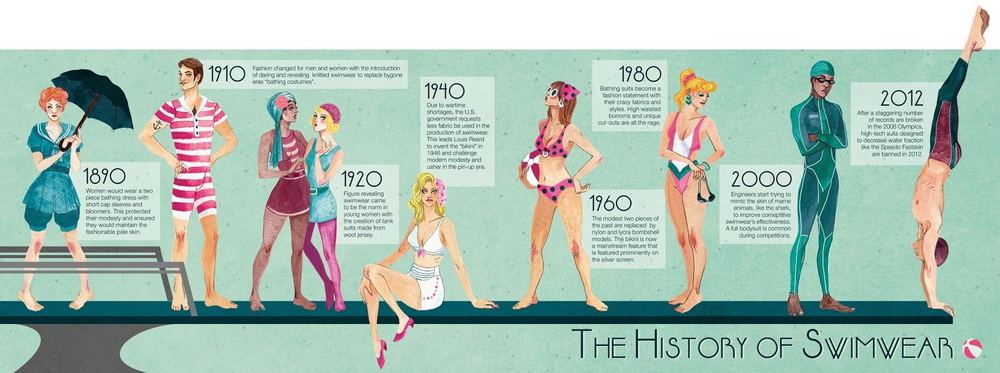Content Menu
● Ancient Origins: The Precursors to Modern Swimwear
● The Middle Ages and Renaissance: A Period of Modesty
● The 19th Century: The Birth of Modern Swimwear
● The Early 20th Century: Streamlining and Functionality
● The Bikini Revolution: A New Chapter in Swimwear History
● Late 20th Century to Present: Innovation and Diversity
● Conclusion: The Ongoing Evolution of Swimwear
When was swimwear invented? This question has intrigued fashion historians and beach enthusiasts alike for generations. The history of swimwear is a fascinating journey that spans thousands of years, reflecting changes in society, culture, and technology. To truly understand when swimwear was invented, we need to dive deep into the annals of history and explore the evolution of bathing attire from ancient civilizations to the present day.

Ancient Origins: The Precursors to Modern Swimwear
When we ask "when was swimwear invented," we must first acknowledge that the concept of specialized clothing for swimming and bathing has existed for millennia. In ancient civilizations such as Egypt, Greece, and Rome, people often swam and bathed nude. However, there is evidence of early forms of swimwear dating back to these times.
In ancient Rome, for instance, mosaic artworks depict women wearing garments resembling modern-day bikinis while engaging in athletic activities. These early forms of swimwear were not specifically designed for swimming but rather for modesty and protection during bathing or sports. So, when considering when swimwear was invented in its most rudimentary form, we could trace it back to these ancient civilizations.

The Middle Ages and Renaissance: A Period of Modesty
During the Middle Ages and Renaissance, the concept of swimwear as we know it today was virtually non-existent. Swimming and bathing were often done in the nude, but with strict segregation of the sexes. Public bathing fell out of favor during this period, partly due to the spread of diseases and partly because of religious and moral concerns.
It wasn't until the 18th century that the idea of sea bathing for health reasons began to gain popularity among the European elite. This marked a crucial turning point in the history of swimwear. As people flocked to coastal resorts, the need for appropriate bathing attire became apparent. However, if we're asking when swimwear was invented in a form recognizable to modern eyes, we need to look to the 19th century.

The 19th Century: The Birth of Modern Swimwear
The 19th century is when swimwear, as a distinct category of clothing, truly began to take shape. This era marked a significant milestone in answering the question "when was swimwear invented?" in terms of purpose-built garments for swimming and bathing.
In the early 1800s, women's swimwear consisted of long, voluminous dresses made of wool or flannel. These "bathing gowns" were far from practical for swimming, being heavy and cumbersome when wet. Men, on the other hand, often wore a type of knee-length drawers. While these garments were designed for modesty rather than functionality, they represent the first real attempts at creating dedicated swimwear.
A pivotal moment in the history of when swimwear was invented came in the mid-1800s with the introduction of the "bloomer" swimsuit for women. Named after women's rights advocate Amelia Bloomer, this style featured a short dress worn over trousers, providing more freedom of movement than previous designs. While still quite modest by today's standards, the bloomer suit was a revolutionary step in the evolution of swimwear.
For men, the late 19th century saw the introduction of the one-piece knitted swimsuit, which covered the torso and upper thighs. This style would remain popular well into the 20th century. So, when we consider when swimwear was invented in a form that began to prioritize function as well as modesty, the 19th century stands out as a crucial period.

The Early 20th Century: Streamlining and Functionality
The dawn of the 20th century brought significant changes to swimwear design, further refining the answer to when swimwear was invented in its more modern forms. The early 1900s saw a gradual shift towards more practical and form-fitting swimwear for both men and women.
One of the most significant developments in the history of when swimwear was invented came in 1907 when Australian swimmer Annette Kellerman was arrested in Boston for wearing a form-fitting one-piece swimsuit that exposed her arms and legs. This incident sparked a debate about swimwear standards and helped pave the way for more practical designs.
The 1920s marked another milestone in the evolution of swimwear. Women's swimsuits became shorter and more form-fitting, often featuring low-cut backs and higher-cut legs. The iconic one-piece maillot, which is still popular today, emerged during this period. For men, swimwear continued to evolve, with trunks becoming shorter and more fitted.
A crucial technological advancement in the history of when swimwear was invented came in 1931 with the invention of Lastex yarn. This elastic fiber revolutionized swimwear design, allowing for the creation of garments that could stretch and retain their shape when wet. This innovation marked a significant leap forward in the functionality and comfort of swimwear.
The Bikini Revolution: A New Chapter in Swimwear History
No discussion of when swimwear was invented would be complete without mentioning the invention of the bikini. This iconic two-piece swimsuit, which has become synonymous with beach culture, was created in 1946 by French engineer Louis Réard. Named after the Bikini Atoll, where atomic bomb tests were being conducted, the bikini was designed to create an explosive cultural reaction.
The introduction of the bikini marks a pivotal moment in the history of when swimwear was invented. It challenged societal norms and pushed the boundaries of what was considered acceptable beachwear. Initially met with shock and controversy, the bikini gradually gained acceptance over the following decades, becoming a symbol of changing attitudes towards body image and sexuality.
The bikini's invention not only revolutionized women's swimwear but also influenced men's styles. In the 1950s and 60s, men's swim trunks became shorter and more fitted, mirroring the trend towards more revealing swimwear.

Late 20th Century to Present: Innovation and Diversity
From the late 20th century to the present day, the evolution of swimwear has been characterized by innovation in materials, designs, and styles. When we consider when swimwear was invented in its most technologically advanced forms, we look to this period.
The introduction of synthetic materials like nylon and spandex in the 1960s and 70s further revolutionized swimwear design. These materials allowed for even more form-fitting and quick-drying swimsuits, ideal for both recreational and competitive swimming.
The late 20th century also saw the rise of specialized swimwear for different purposes. Competitive swimmers began wearing high-tech bodysuits designed to reduce drag and improve performance. Surfwear evolved into its own category, with the invention of board shorts and rash guards. For beachgoers, options expanded to include everything from tiny string bikinis to more modest tankinis and swim dresses.
In recent years, the focus has shifted towards sustainability and inclusivity in swimwear design. Many brands are now using recycled materials and eco-friendly production methods to create swimwear. There's also been a push towards more diverse sizing and styles to accommodate different body types and cultural preferences.

Conclusion: The Ongoing Evolution of Swimwear
So, when was swimwear invented? As we've seen, the answer is not straightforward. The concept of specialized clothing for swimming and bathing has existed for thousands of years, evolving alongside changes in society, culture, and technology.
If we consider the most basic forms of swimwear, we could trace its origins back to ancient civilizations. However, if we're looking at when swimwear was invented as a distinct category of clothing designed specifically for swimming and bathing, we would point to the 19th century.
The invention of the modern bikini in 1946 marks another significant milestone in the history of when swimwear was invented, revolutionizing beach fashion and challenging societal norms.
Today, swimwear continues to evolve, with ongoing innovations in materials, designs, and manufacturing processes. From the woolen bathing gowns of the 19th century to the high-tech competitive swimsuits of today, the history of when swimwear was invented is a testament to human ingenuity and our enduring love affair with water.
As we look to the future, it's clear that the story of when swimwear was invented is far from over. With advancements in textile technology, changing social attitudes, and a growing emphasis on sustainability, the swimwear of tomorrow may be vastly different from what we know today. Yet, it will still be part of the long and fascinating history that began with the simple question: when was swimwear invented?





































































